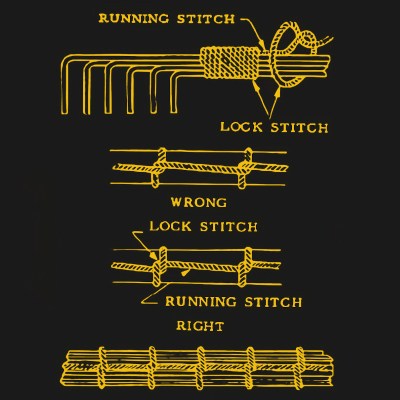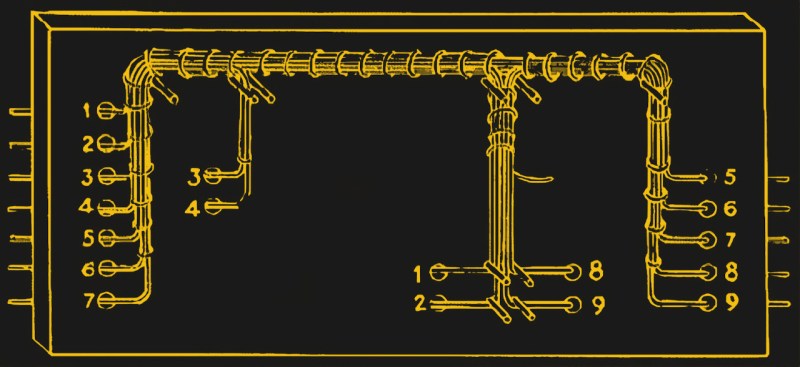Cable harnesses made wire management a much more reliable and consistent affair in electronic equipment, and while things like printed circuit boards have done away with many wires, cable harnessing still has its place today. Here is a short how-to on how to lace cables from a 1962 document, thoughtfully made available on the web by [Gary Allsebrook] and [Jeff Dairiki].
 It’s a short resource that is to the point in all the ways we love to see. The diagrams are very clear and the descriptions are concise, and everything is done for a reason. The knots are self-locking, ensuring that things stay put without being overly tight or constrictive.
It’s a short resource that is to the point in all the ways we love to see. The diagrams are very clear and the descriptions are concise, and everything is done for a reason. The knots are self-locking, ensuring that things stay put without being overly tight or constrictive.
According to the document, the ideal material for lacing cables is a ribbon-like nylon cord (which reduces the possibility of biting into wire insulation compared to a cord with a round profile) but the knots and techniques apply to whatever material one may wish to use.
Cable lacing can be done ad-hoc, but back in the day cable assemblies were made separately and electrically tested on jigs prior to installation. In a way, such assemblies served a similar purpose to traces on a circuit board today.
Neatly wrapping cables really has its place, and while doing so by hand can be satisfying, we’ve also seen custom-made tools for neatly wrapping cables with PTFE tape.















That’s how I was taught in 1992!
In the UK the spec was part of DEF5000 & how I was taught in 1982 as a prototype wireman. I never did use the skill in my day job but my projects all looked tidy but of course I soon switched to heat-shrink.
Learned this in the military 1967,
I learned this around the same time (BTec and C&G Electronics) and did actually use it a few times too but mostly out of bloody mindedness and to prove I could do it.
It does look great though, no matter how well they work heatshrink, cableties etc. just don’t have the same sort of ‘charm’
I’m curious where because ever since the invention of traps this has really been a thing. I started as a helper in 1977 and never saw it done.
Connections Museum did a great video a few years ago demonstrating how telephone exchange wiring is cut to length and laced: https://youtu.be/GTC_r9AIgdo .
One of the things I gathered from the video is that using all solid core wire is a big part of getting those defined bends and structure.
I have done this a lot. Lacing tape comes in waxed or non wax types. They still sell it. It’s about 1/8th inch wide, thin nylon tape. Tape is better than cord as it does not cut into insulation under heavy vibration. The wax type has the advantage of sticking at the crossover for tension retention and keeps it from unraveling if a strand is broken.
Proper lacing not only confers practical engineering benefits, when done by someone competent in the art, it is a thing of beauty.
I’ve seen complex test panels where the craftsmanship and artistry of the lacing was such that it would not have seemed out of place if on display at the Louvre.
Yes. There are hidden works of art in teleco rooms across the country (along with eldritch creations that would out-do the Flying Spaghetti Monster, sometimes in the same building!)
My preferred material for lacing cables is the telco standard 9 strand wax-impregnated cord. The only catch with it is that it makes a hellacious mess if it gets hot, and the wax tends to go _everywhere_.
Sadly, for modern data centers, cable lacing takes too long and time is money ::spit:: so velcro wrap has mostly supplanted it. (and when it’s done right, it still looks ‘good enough’.)
I did aircraft wiring back in the 1980s and we used nomex instead of nylon. Typically unwaxed. Never melts. It’s the same stuff they use for flight suits in the military.
Back when more electronics were built in Canada (eg broadcast audio companies McCurdy, Ward-Beck) their cable harnesses were definitely works of art. It made me cringe to have to add to or modify wiring, because it would never be as nice again.
But let’s face it, if you’re hacking together a customized project that won’t be duplicated, and may very well be altered in future, a sexy wiring harness is low on the list of priorities. And tight harnessing can cause or increase bleed/crosstalk.
“back in the day cable assemblies were made separately and electrically tested”
It’s still done that way e.g. automotive and heavy equipment
I had an opportunity to tour a factory making wiring harnesses the old school way for various military vehicles and they still used plywood jigs with pegs to bend the wires around and multicolored sharpie lines to show which wire went where.
I imagine their labor costs were high, but they had a good track record of building sturdy and correct wiring harnesses for high value low volume applications where they had to function in harsh environments and craftsmanship mattered.
They had put a lot of thought over the decades into which steps were best automated vs. which steps needed a human on account of requiring a combination of dexterity, intelligence, and judgement and thus it was interesting to see how some steps like measuring, cutting, stripping, and labeling were automated, but winding, binding, and crimping connectors was very much the domain of experienced people.
Here is one such company, notice that most of the la or is done in Mexico and China.
https://www.ecintl.com/company/
https://hackaday.com/2016/11/03/specifications-you-should-read-the-nasa-workmanship-standards/
When I was taught to do this at Hughes Aircraft in ’60 we used a clove hitch with a square knot to secure it. I still have a roll of that lacing ribbon and use it occasionally.
Yeah, I still have reel in my drawer (mine is from the RAF) and it’s pretty indestructible!
sail making whipping twine for this is a good alternative, as it is waxed and reasonably thin.
NASA has a thing titled: “CABLE AND HARNESS GENERAL REQUIREMENTS”. See here:
https://workmanship.nasa.gov/lib/insp/2%20books/links/sections/401%20General%20Requirements.html
First thing I thought of as well! Those were probably applied on the rovers on Mars, check out some of the lacing here: https://mars.nasa.gov/mars2020/multimedia/raw-images/
When I Google Image search for “Lacing Ribbon” I get a ribbon that’s meant to be tied around something and then promptly removed ;-)
I was expecting a crackley old periscope film on how to do it. Reading is way too hard.
Waxed, ribbon dental floss (hopefully unused) … that is if you don’t want the real stuff (use your less than totally evil search engine and search for waxed lacing cord).
I remember going to DMS-100 training for Nortel. Worked at Verizon sites. Verizon had an issue somewhere with cable ties that resulted in them being banned. Everything in their central offices were done with waxed string. You had to learn what I’ve thought ever since as very useful methods of knots and wire bundling. It was important to have all the cable bundles parallel so that you could slide a flat piece of metal through and expand the bundles later.
You find out how good at lacing you are when you do a vertical drop two floors in a fire containment separation taking line cables from the switch room to the main distribution frame. There were so many 50 pair cables that they were getting stacked 8 deep on top of the drop ladder.
You lace the first cables that are going to the frame directly to the ladder, and as more analog lines need to to to the frame you add the next row to drop down the frame into the stack. One ladder could handle 48 cables laced next to each other (there were multiple ladder holes to accommodate the switch. So each hole served just over 19k analog lines.
We were switching from digital control with analog relays (ess4 level tech, or Stromberg’s digital controlled relay switch) to the digital Time-Space-Time switches that used T1’s as the main way to work. This is also the same time that SCARRY GOVERNMENT BOOGIES placed sun workstations into every exchange that had scripts that could duplicate any t1 circuit to it’s input. Let’s say I was never sure how secure those systems passwords were.
But after all this, lacing and fire brick work are not totally lost arts, even if I do not practice them myself. There are plenty of people that I have taught the do microwave or other installation work that can still make more stiches than you have seen in this article.
I believe, in the spirit of my 60’s lacing coach, and the *ss holes that inspected my lacing and found a crossed stich, that the art will go on.
-C
One other thing this misses is using lacing hooks or needles to do Chicago or Saint Luis style stitching. Which is required for those vertical style drops. I never heard why those style stiches had those names, so lost to history for me.
The last thing, anyone that ever did this kind of lacing will know, they have a worn spot000 on the outside of their pinky finger where the string rode as you tightened the knots.
-C
For smaller cables, waxed dental floss works well.
I think it is still taught in A&P school.
Miles and Miles if white aviation wrie behind a panel are nearly wrapped in wax covered string.
FAA AC43.13 Acceptable Methods, Techniques, and Practices illustrates it
I learned to do lacing from the USAF in aircraft maintenance, and we always had rolls of waxed leaving string in the tool crib (or in your box if you were an avionics tech….)
I was still taught this as part of a two engineering course in the Royal Navy back in early 2000s. We made an RC meter and a basic multimeter. Designed and etched all the boards, fabricated all of the enclosures from aluminium sheet and laced all the cables. If I did any projects now I would still have a go at this as it looks so much better. Almost a work of art.
I see this inside motors to this day on the windings, before it’s all varnished.
At work I use zip ties but I do this to a lot of my projects.
I had to take a class in MIL SPEC lacing in my early years. They had a knot for everything. I use it when I can because zip ties have that buckle which is like a skin knife if your cutter does not cut completely flush. (Had a guy make a 6″ slice in his arm that way building a machine). Cheap zip tie guns do not do a good job of flush cutting the end. Also, the buckles catch on everything when you try to string them. Velcro works but can’t hold as tight.